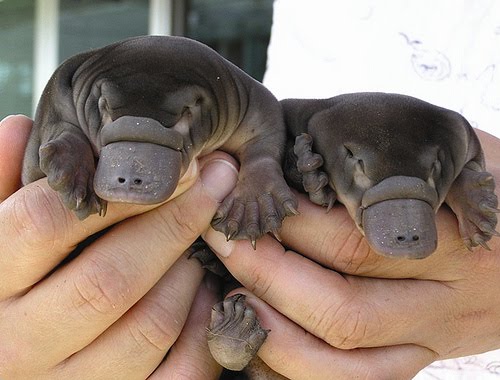


The music in the clip was produced by music director Kevin Hocking (1932-) working with the Melbourne Symphony Orchestra. As the platypus dives under water seeking its prey, the eerie haunting sounds of the xylophone rise and fall, adding tension. The strangeness of the platypus is emphasised in the clip through the use of xylophone music. Body temperature in the water is maintained by insulating body fur and an internal heat exchange system that minimises heat loss through extremities. As seen in the clip, their body shape is streamlined, with fully webbed front feet used for propulsion, and partially webbed back feet used as rudders. Platypuses are out of their burrows for up to 16 h of the day and night, spending much of this time foraging in water, and are well adapted to their aquatic environment. The burrow seen here is probably a nesting one as their entrances tend to be above the water level and are usually built among tree roots to prevent collapse. Found around permanent freshwater lakes and creeks in Queensland, New South Wales, Victoria, South Australia and Tasmania, platypuses occupy two types of burrows, nesting burrows and resting or camping burrows, that are dug into the banks of waterways or located in piles of accumulated debris.
REAL LIFE BABY PLATYPUS SERIES
The platypus ejects anything it does not want through a series of horny serrations near both ends of its lower jaw. The plates are sharp ridges near the front of the mouth but become flat towards the back. Unlike juveniles, which have three molars, adult platypuses have flattened horny plates, and the clip reveals their use in crushing and grinding food in close-ups filmed from below of the platypus 'chewing' its food on the surface. There are also 46,500 mechanical receptors that pick up the mechanical displacement waves of moving prey.
REAL LIFE BABY PLATYPUS SKIN
The bill skin contains 40,000 of one type of electroreceptor and 13,500 of another type, enabling it to receive the electrical signals that emanate from prey such as worms and molluscs. With its eyes and nostrils sealed under water, the platypus's ability to obtain a three-dimensional sense of its prey depends on arrays of sensory receptors in its bill. Its scientific classification is Phylum: Chordata, Class: Mammalia, Subclass: Prototheria, Order: Monotremata, Family: Ornithorhynchidae. It is also the only mammal known to use a complex system of electroreceptors to locate its prey. Educational value The platypus ('Ornithorhynchus anatinus') is an endangered species and among Australia's most distinctive animals - one of only three living monotremes (egg-laying mammals) in the world and the only one that is amphibious.


 0 kommentar(er)
0 kommentar(er)
